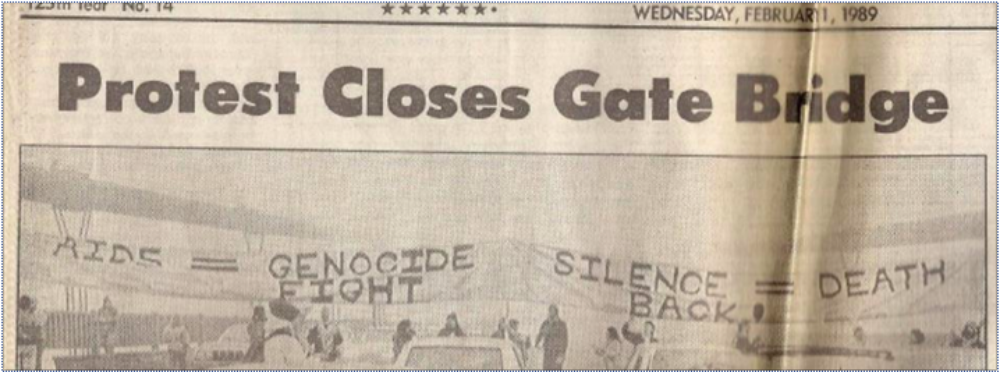Bay Area based journalist and activist Kate Raphael gave a talk last month entitled “AIDS Activism and Beyond: Radical Queer Politics of the ‘80s and 90s”, as part of the Radical History series organized by AID and ABET. Amanda Ream was in attendance and wrote this summary for Visual AIDS.
“Stop AIDS Now… or else” read the banner that blocked the Golden Gate Bridge during the morning commute on January 21st 1989.
It was held up by activists including Terry Eaton and other PWAs who were literally dying on their feet. As Kate remembers, she drove Terry directly from the Golden Gate Bridge to the hospital for his blood transfusions. Soon he, and many of the organizers of that historic action, would be dead.
Theses activists were from, AIDS Action Pledge, who would later become, ACT UP San Francisco (ACT UP SF). They were a seasoned group of organizers. Many of them knew each other from work in the peace movement, fighting US imperialism, and wars in El Salvador and Nicaragua. They worked from an intersectional understanding of power and US politics--a framework they shared, seeing the structural issues of racism, homophobia and capitalism as the driving forces behind government inaction on AIDS.
They knew how to organize because they had done it for political prisoners, against apartheid in South Africa, and for police accountability. Hundreds of people joined ACT UP SF in a search to feel connected, to do something about AIDS because they, their best friend, and lovers were dying. When they found ACT UP, they found a movement. The experienced organizers made sure of it. It was never the agenda of ACT UP SF to be entirely about AIDS. AIDS, like prisons, or war, became the flashpoint for understanding inequality. For the first time for many of these activists, they weren’t working in solidarity. The bullseye of oppression was on their backs.
A new culture began to emerge with patients and sick people at the forefront of decision making, and men and women sharing power in ways they had not in the male-dominated political left or the women’s only spaces of the 70s and early 80s. Women, and in particular lesbians, had primarily worked in the women’s movement, to end rape, start feminist health centers and to create lesbian community. AIDS drew these women into a shared fight with gay men against homophobia.
“The women’s movement”, said Raphael, “never really recovered from the departure of so many lesbians into the demands of the AIDS crisis.”
In October 1989 as part of a national day of action: “Living with AIDS and Fighting Back,” 50 activists blocked Market Street in the Castro and the police went out of control. As 500 marchers watched, the San Francisco Police Department charged the men and women sitting down and linking arms in the street in an act of civil disobedience. Beating them with clubs and dragging them across the street, blood covered the faces of protestors and splattered the pavement.
Kate’s talk contained images of these events many of us had never seen before. The pictures conveyed that these were heavy times. More than 15,000 people died in San Francisco during that decade.
In June 1990, ACT UP San Francisco hosted activists from all over the country to protest at the Sixth International AIDS Conference.
“We protested many aspects of the way AIDS was being handled at the top - including the fact that the conference was off limits to the people who needed the information most, because the United States immigration service excluded people with HIV from entering the country. We also protested the fact that the famed ‘San Francisco model’ of AIDS care was based on volunteerism rather than adequate public funding,” said Raphael.
Nights like this talk are important these days. Kate’s talk brought together three generations of AIDS activists. We talked about the thread that connects us all: love for our people, and for our city. Reformed to commemorate the 25th anniversary of ACT UP last year, ACT UP SF is back. On April 20 the group will hold a protest under the banner “Housing=Healthcare” to draw attention to the increasing pressures of gentrification and evictions facing our communities in the Bay Area.
This week longtime gay men’s health organizer and owner of a Castro travel agency, Jonathan Klein, jumped to his death off of the Golden Gate Bridge after an eviction. A sign in front of his store read this morning “Eviction=Death,” placed there by members of ACT UP SF.
Kate and her affinity group of friends, who once went by the name “Fat Dykes From Hell,” provide us with the context to understand these events, and what it means to be an AIDS activist, and an organizer in San Francisco today. The impact of their work, and their longevity is inspiring, particularly at a time when an older generation of queers are actively under attack by real estate and elected officials—pushed out of the neighborhoods they established as safe zones for queers. Kate’s message has always been about justice, and its one we need to tap deeply into right about now. With thousands marching up Market Street for marriage equality, Kate reminds us who we were in a time of great crisis, and who we are today—fighters for a deeper, more lasting freedom.
As part of her talk Kate Raphael went through her film archives. To view a clip she assembled that combines news coverage of the protests with DIY footage from Electric City Cheap TV click here.
Amanda Ream is a union organizer in San Francisco working on healthcare and immigration justice. She is part of ACT UP SF and got her start in activism, like a lot of people, waking into a meeting of ACT UP NY in the 1990s and being a Lesbian Avenger.
